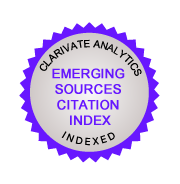Ammonium Adsorption from Water by Macadamia Husk-Derived Biochar Forms: Mechanism and Behavior Study
Phuong Van Nguyen(1*)
(1) Institute of Environmental Science, Engineering and Management, Industrial University of Ho Chi Minh City, 12 Nguyen Van Bao Street, Hanh Thong Ward, Ho Chi Minh City 700000, Vietnam
(*) Corresponding Author
Abstract
Keywords
Full Text:
Full Text PDFReferences
[1] Khalil, A., Sergeevich, N., and Borisova, V., 2018, Removal of ammonium from fish farms by biochar obtained from rice straw: Isotherm and kinetic studies for ammonium adsorption, Adsorpt. Sci. Technol., 36 (5-6), 1294–1309.
[2] Xu, H., Wang, B., Zhao, R., Wang, X., Pan, C., Jiang, Y., Zhang, X., and Ge, B., 2022, Adsorption behavior and performance of ammonium onto sorghum straw biochar from water, Sci. Rep., 12 (1), 5358.
[3] Gao, F., Xue, Y., Deng, P., Cheng, X., and Yang, K., 2015, Removal of aqueous ammonium by biochars derived from agricultural residuals at different pyrolysis temperatures, Chem. Speciation Bioavailability, 27 (2), 92–97.
[4] Sizmur, T., Fresno, T., Akgül, G., Frost, H., and Moreno-Jiménez, E., 2017, Biochar modification to enhance sorption of inorganics from water, Bioresour. Technol., 246, 34–47.
[5] Lesbani, A., Palapa, N.R., Sayeri, R.J., Taher, T., and Hidayati, N., 2021, High reusability of NiAl LDH/biochar composite in the removal methylene blue from aqueous solution, Indones. J. Chem., 21 (2), 421–434.
[6] Minh, V.C., Huy, N.N., Thi, T.N., and Le Nguyen, L.T., 2025, Adsorption characteristics of coconut husk biochar for organics in water, Indones. J. Chem., 25 (3), 730–743.
[7] Fan, R., Chen, C., Lin, J., Tzeng, J., Huang, C., Dong, C., and Huang, C.P., 2019, Adsorption characteristics of ammonium ion onto hydrous biochars in dilute aqueous solutions, Bioresour. Technol., 272, 465–472.
[8] Fidel, R.B., Laird, D.A., and Spokas, K.A., 2018, Sorption of ammonium and nitrate to biochars is electrostatic and pH-dependent, Sci. Rep., 8 (1), 17627.
[9] Zhang, M., Song, G., Gelardi, D.L., Huang, L., Khan, E., Mašek, O., Parikh, S.J., and Ok, Y.S., 2020, Evaluating biochar and its modifications for the removal of ammonium, nitrate, and phosphate in water, Water Res., 186, 116303.
[10] Wang, Z., Li, J., Zhang, G., Zhi, Y., Yang, D., Lai, X., and Ren, T., 2020, Characterization of acid-aged biochar and its ammonium adsorption in an aqueous solution, Materials, 13 (10), 2270.
[11] Shakoor, M.B., Ye, Z.L., and Chen, S., 2021, Engineered biochars for recovering phosphate and ammonium from wastewater: A review, Sci. Total Environ., 779, 146240.
[12] Phuong, N.V., Hoang, N.K., Luan, L.V., and Tan, L., 2021, Evaluation of NH4+ adsorption capacity in water of coffee husk-derived biochar at different pyrolysis temperatures, Int. J. Agron., 2021 (1), 1463814.
[13] Van Phuong, N., 2025, Mechanism and behavior of phosphorus adsorption from water by biochar forms derived from macadamia husks, Nat., Environ. Pollut. Technol., 24 (1), D1703.
[14] Chung, H.K., Kim, W.H., Park, J., Cho, J., Jeong, T.Y., and Park, P.K., 2015, Application of Langmuir and Freundlich isotherms to predict adsorbate removal efficiency or required amount of adsorbent, J. Ind. Eng. Chem., 28, 241–246.
[15] Qureshi, S.S., Memon, S.A., ul‑Zaman, R., Ram, N., Saeed, S., Mubarak, N.M., and Karri, R.R., 2022, Rapid adsorption of selenium removal using iron manganese‑based micro adsorbent, Sci. Rep., 12, 1–13.
[16] Dai, Y., Wang, W., Lu, L., Yan, L., and Yu, D., 2020, Utilization of biochar for the removal of nitrogen and phosphorus, J. Cleaner Prod., 257, 120573.
[17] Zhao, S.X., Ta, N., and Wang, X.D., 2017, Effect of temperature on the structural and physicochemical properties of biochar with apple tree branches as feedstock material, Energies, 10 (9), 1293.
[18] Luo, D., Wang, L., Nan, H., Cao, Y., Wang, H., Kumar, T.V., and Wang, C., 2023, Phosphorus adsorption by functionalized biochar: A review, Environ. Chem. Lett., 21 (1), 497–524.
[19] Ogasawara, H., Horimoto, N., and Kawai, M., 2000, Ammonia adsorption by hydrogen bond on ice and its solvation, J. Chem. Phys., 112 (19), 8229–8232.
[20] Wang, S., Zhao, H., Liu, J., Wang, X., Li, J., Shi, E., Wang, C., Yang, J., and Zhang, Z., 2023, A study on and adsorption mechanism of ammonium nitrogen by modified corn straw biochar, R. Soc. Open Sci., 10 (2), 221535.
Article Metrics
Copyright (c) 2025 Indonesian Journal of Chemistry

This work is licensed under a Creative Commons Attribution-NonCommercial-NoDerivatives 4.0 International License.
Indonesian Journal of Chemistry (ISSN 1411-9420 /e-ISSN 2460-1578) - Chemistry Department, Universitas Gadjah Mada, Indonesia.












